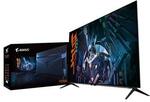These are back in-stock. Not the cheapest but still sell out quickly.
Only just got it home and haven't set it up yet.
New Firmware became available on 17/6/22. Version: F06
It's a stripped down version of the LG C1 48" which has been discounted as low as $1615 but stock is getting scarce.


how do these compare to the LG/Sony OLEDs other than being smaller? thinking it would make a good bedroom tv